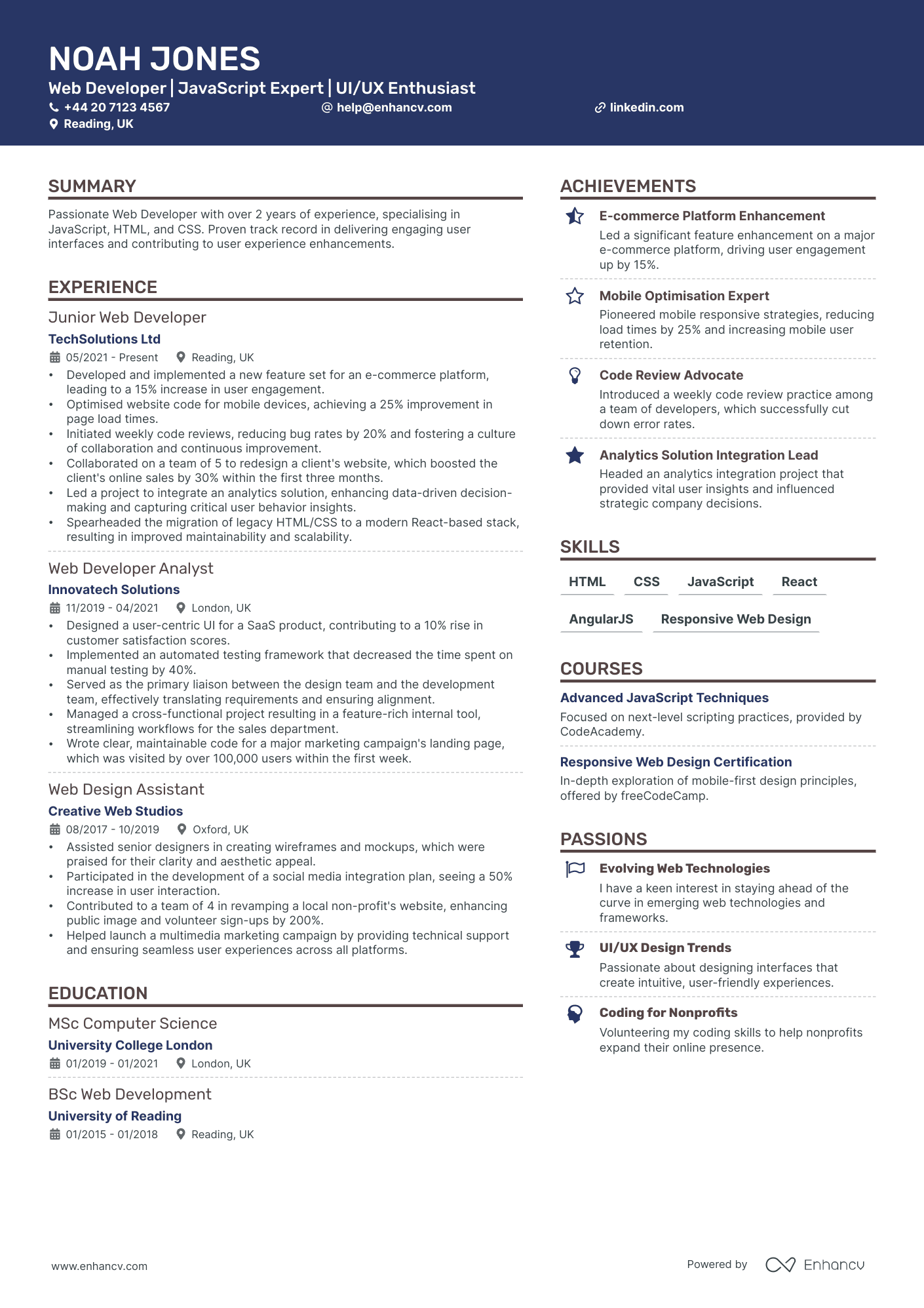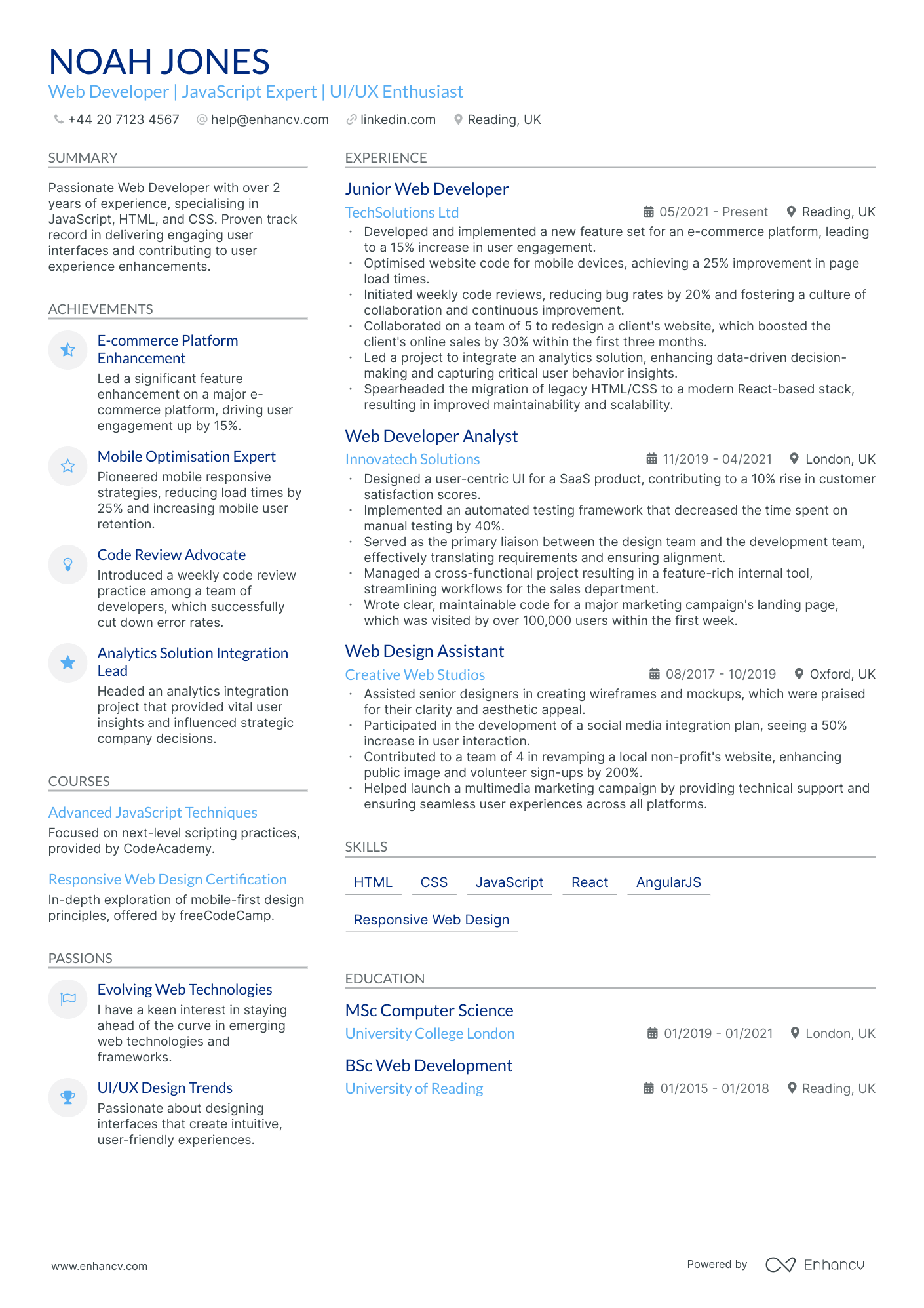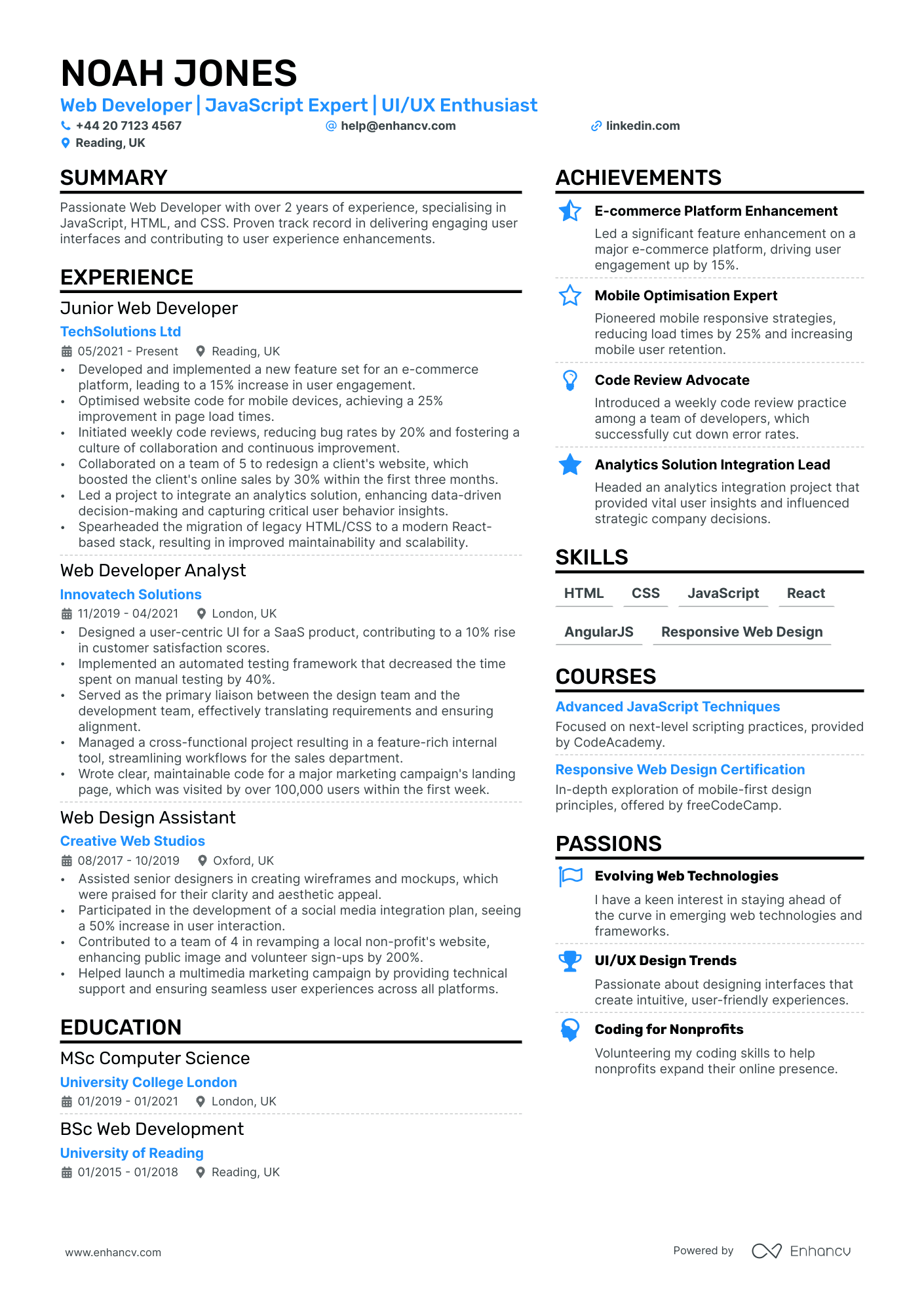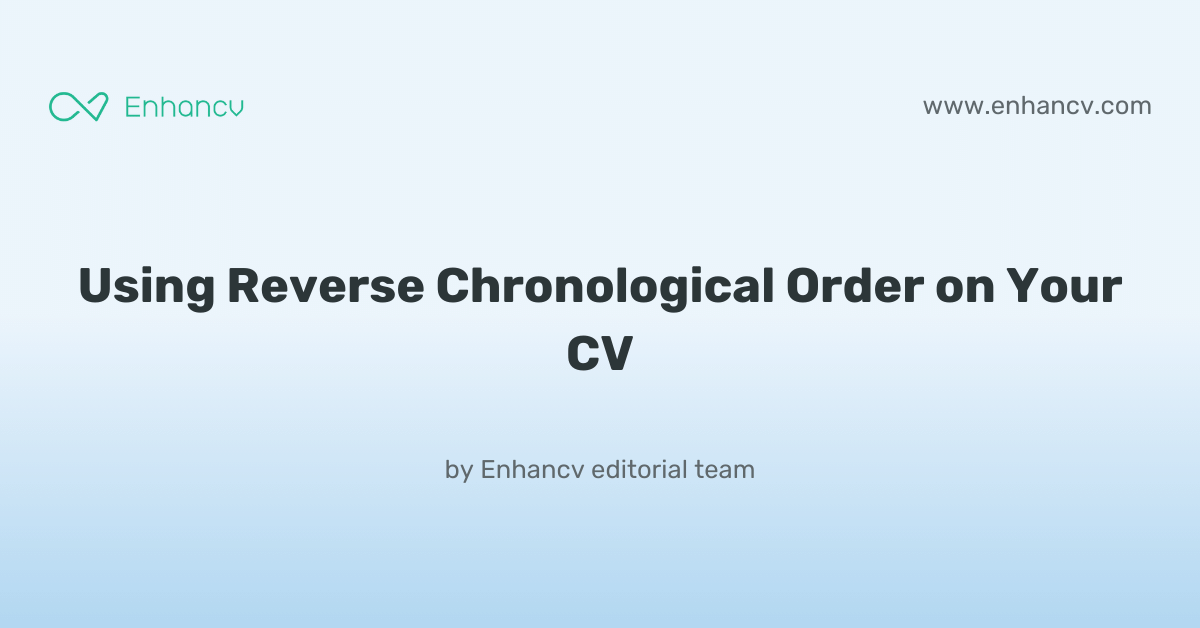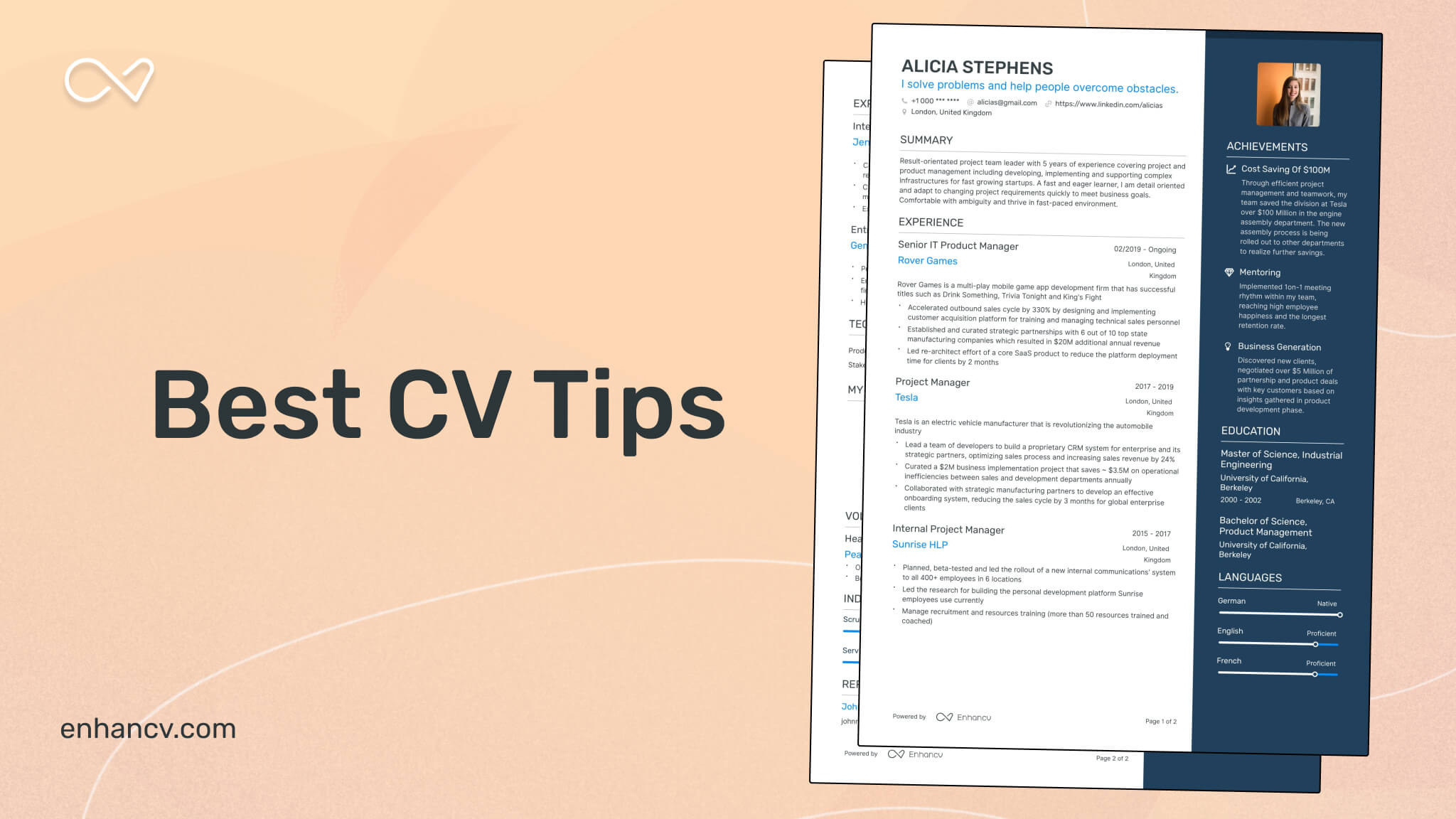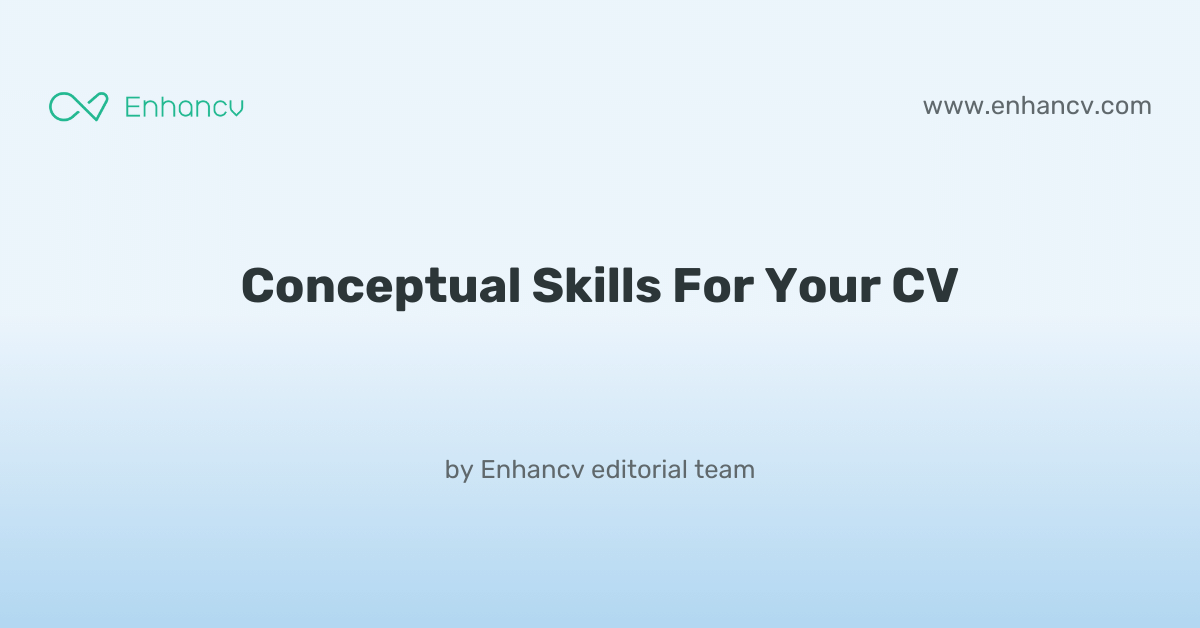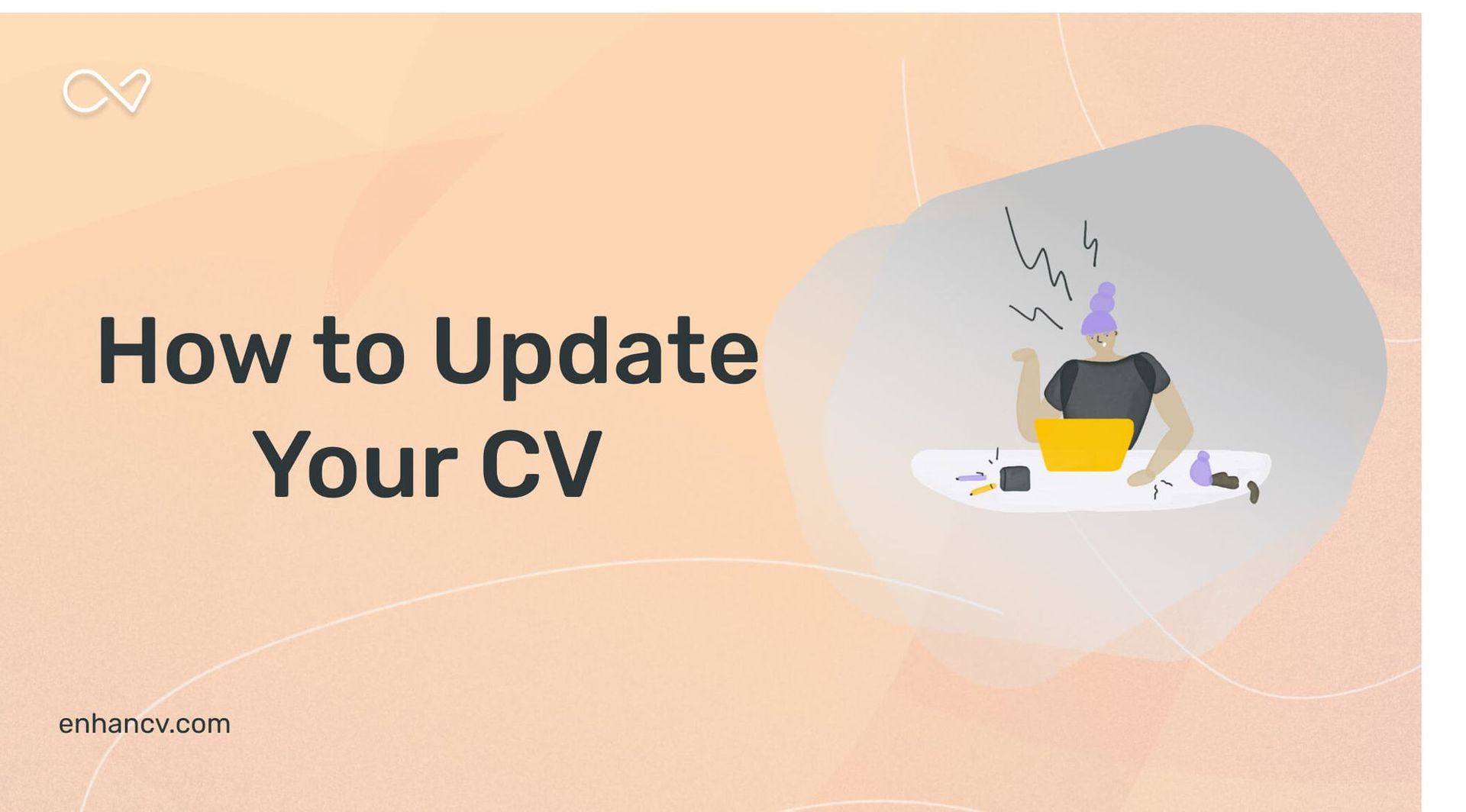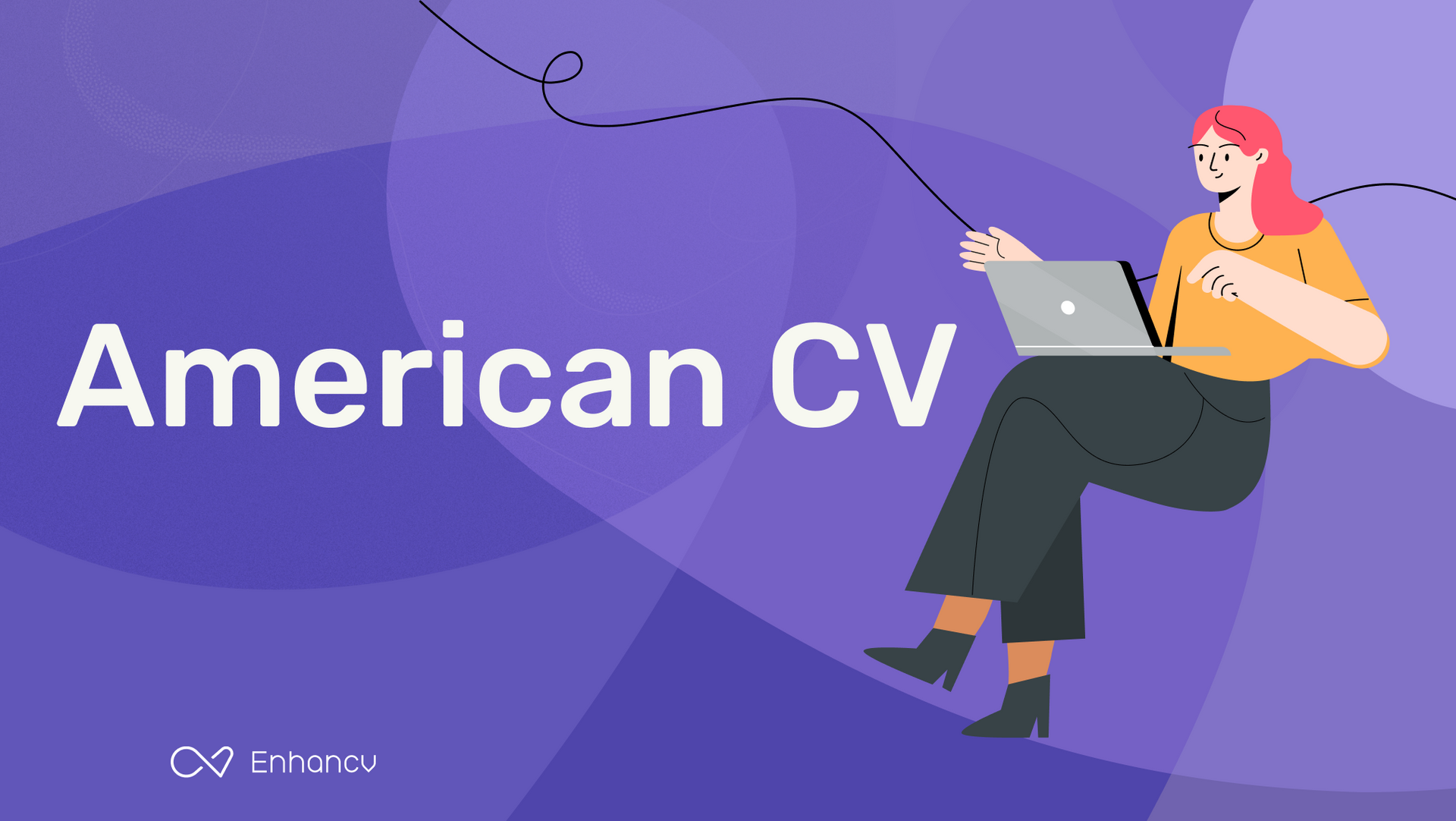Keeping your CV updated with the latest front end development technologies and projects can be a daunting task due to the rapid pace of change in the industry. Our guide will provide you with concise strategies to highlight your skills and experiences effectively, ensuring your CV remains at the forefront of innovation.
- Applying best practices from real-world examples to ensure your profile always meets recruiters' expectations;
- What to include in your work experience section, apart from your past roles and responsibilities?
- Why are both hard and soft skills important for your application?
- How do you need to format your CV to pass the Applicant Tracker Software (ATS) assessment?
If you're writing your CV for a niche front end developer role, make sure to get some inspiration from professionals:
Structuring your front end developer CV layout: four factors to keep in mind
There are plenty of best practices out there for your CV layout and design. At the end of the day, a clear format and concise CV message should be your top priority. Use your CV design to enhance separate sections, bringing them to the forefront of recruiters' attention. At the same time, you can write content that:- Follows the reverse chronological order in the experience section by first listing your most recent jobs;
- Incorporates your contact information in the header, but do skip out on the CV photo for roles in the UK;
- Is spotlighted in the most important sections of your CV, e.g. the summary or objective, experience, education, etc. to show just how you meet the job requirements;
- Is no longer than two-pages. Often, the one-page format can be optimal for your front end developer CV.
Before submitting your CV, you may wonder whether to export it in Doc or PDF. With the PDF format, your information and layout stay intact. This is quite useful when your CV is assessed by the Applicant Tracker System (or the ATS) . The ATS is a software that scans your profile for all relevant information and can easily understand latest study on the ATS , which looks at your CV columns, design, and so much more.
PRO TIP
Use bold or italics sparingly to draw attention to key points, such as job titles, company names, or significant achievements. Overusing these formatting options can dilute their impact.
The top sections on a front end developer CV
- Professional Summary showcases your career highlights and skills.
- Technical Skills section details your coding languages and tools.
- Work Experience demonstrates your impact on previous projects.
- Portfolio gives a visual insight into your design capabilities.
- Education & Certifications prove your formal training and expertise.
What recruiters value on your CV:
- Highlight your knowledge of front-end technologies such as HTML, CSS, and JavaScript, including frameworks such as React, Vue, or Angular, to demonstrate your skills are up to date with current industry standards.
- Provide examples of responsive and accessible web design you've worked on, as this showcases your commitment to providing a quality user experience across various devices and for all users.
- Include links to your personal coding projects, GitHub repositories, or live websites you've developed, as this gives potential employers tangible proof of your coding skills and style.
- Emphasise experience with version control systems like Git and development tools like Webpack or Gulp, which shows that you understand the importance of code maintainability and workflow optimization.
- Document your ability to work with designers and back-end developers by detailing projects where cross-functional teamwork was essential, revealing your collaborative and communication skills.
Recommended reads:
Our checklist for the must-have information in your front end developer CV header
Right at the very top of your front end developer CV is where you'd find the header section or the space for your contact details, headline, and professional photo. Wondering how to present your the name of the city you live in and the country abbreviation as your address;
- are tailored to the role you're applying for by integrating key job skills and requirements;
- showcase what your unique value is, most often in the form of your most noteworthy accomplishment;
- select your relevant qualifications, skills, or current role to pass the Applicant Tracker System (ATS) assessment. Still not sure how to write your CV headline? Our examples below showcase best practices on creating effective headlines:
Examples of good CV headlines for front end developer:
- Front End Developer | JavaScript Expert | React Enthusiast | UX/UI Focus | 5+ Years Experience
- Senior Front End Engineer | Full-Stack Capabilities | Agile Methodologies | Certified Web Professional
- Lead Front End Developer | User-Centric Design | Mentor | Vue.js | 8 Years Industry Practice
- Junior Front End Specialist | HTML/CSS Prodigy | Responsive Design | Bootcamp Graduate | Quick Learner
- Progressive Web App Developer | Angular Authority | Performance Optimization | 10 Years Crafting Code
- Creative Front End Architect | Innovative UI Solutions | Accessibility Advocate | Scrum Master | 6 Years Expertise
Choosing your opening statement: a front end developer CV summary or objective
At the top one third of your CV, you have the chance to make a more personable impression on recruiters by selecting between:
- Summary - or those three to five sentences that you use to show your greatest achievements. Use the CV summary if you happen to have plenty of relevant experience and wish to highlight your greatest successes;
- Objective - provides you with up to five sentences to state your professional aims and mission in the company you're applying for
CV summaries for a front end developer job:
- Seasoned Front End Developer with over 8 years of experience, adept in React and Angular, with a proven track record in boosting user experience by 40% for a major e-commerce platform through innovative interface redesigns and performance enhancements.
- Dynamic professional with a background in graphic design, possessing 5 years of experience, transitioning into Front End Development. Brings a strong aesthetic sense combined with newfound proficiency in JavaScript, CSS, and HTML to create compelling and responsive web designs.
- With a decade of experience at a leading tech firm, this Front End Developer has mastered the full stack of web technologies, including Vue.js and Node.js, and led the successful launch of a mobile-first progressive web application that attracted over 1 million users in its first year.
- Former Back End Developer with 4 years of Python experience undertaking a career shift towards Front End technologies. Strong desire to leverage deep understanding of server-side mechanics to produce seamless integrations between user interfaces and back end architecture using JavaScript frameworks.
- Eager to apply my creativity and passion for web technologies in a front-end centric role, drawing upon self-taught skills in JavaScript, CSS, and HTML and a keen interest in creating user-centric web solutions that enhance engagement through intuitive design and functionality.
- Dedicated individual with a profound interest in Front End Development, aiming to utilise a robust foundation in computer science and independent learning in modern web development practices to contribute to projects that improve user experience and accessibility on the web.
Narrating the details of your front end developer CV experience section
Perhaps you've heard it time and time again, but, how you present your experience is what matters the most. Your CV experience section - that details your work history alongside your accomplishments - is the space to spotlight your unqiue expertise and talents. So, avoid solely listing your responsibilities, but instead:
- adverts' keywords and integrate those in your experience section;
- Use your CV to detail how you've been promoted in the past by including experience in the reverse chronological order.
Before you start writing your front end developer CV experience section, dive into some industry-leading examples on how to structure your bullets.
Best practices for your CV's work experience section
- Designed and implemented responsive web applications ensuring high performance on mobile and desktop, adhering to best SEO practices.
- Collaborated with UX/UI designers to refine and translate designs and wireframes into high-quality code, enhancing user experience.
- Maintained and improved website performance, utilising profiling tools and code audits to identify and rectify bottlenecks.
- Developed robust, maintainable code using JavaScript frameworks like React, Angular, or Vue.js to deliver dynamic user experiences.
- Integrated RESTful APIs and other back-end services seamlessly, ensuring smooth data retrieval and system interactions.
- Ensured cross-browser compatibility and resolved issues by testing on a variety of browsers and devices.
- Participated in code reviews to uphold coding standards and shared best practices with the development team.
- Leveraged modern build tools like Webpack and task runners like Gulp to automate workflow processes and improve efficiency.
- Implemented unit and end-to-end tests using frameworks like Jest or Selenium to ensure the reliability and stability of front-end components.
- Led a team of 6 front end developers in creating a highly responsive web application for e-commerce, resulting in a 30% increase in user engagement.
- Spearheaded the transition to a React-based front-end, coupled with Redux for state management, which cut down page loading time by 40%.
- Pioneered the implementation of automated front-end testing procedures that brought down reported UI bugs by 60%, enhancing overall software quality.
- Developed and maintained the user interface of a large-scale financial analytics platform using AngularJS, handling over 10,000 active users monthly.
- Optimized website performance and accessibility, achieving a 95% score on Lighthouse by implementing modern web standards and SEO best practices.
- Collaborated closely with UX designers to deliver a complete redesign of the customer portal, which elevated customer satisfaction scores by 25%.
- Revamped and optimized the front end of a legacy CRM system for a tech giant, increasing system efficiency by streamlining client-side scripts.
- Introduced responsive web design techniques to the organization, enabling a seamless cross-device user experience and a 20% uptick in mobile traffic.
- Collaborated on the development of a feature-rich single-page application (SPA) using Backbone.js and Marionette, which significantly enhanced customer retention rates.
- Managed front end development of an enterprise-level intranet, empowering over 5,000 employees with improved navigation and interactive features.
- Implemented a CSS preprocessor (Sass) workflow that standardised styling across products and increased development efficiency by 15%.
- Played a key role in a cross-functional team for a major rebranding initiative, ensuring all web properties accurately reflected the new corporate identity.
- Contributed to the development of a content-rich website for a leading news outlet, enhancing the user experience for over 1 million unique visitors per month.
- Utilised AJAX and jQuery for creating dynamic content updates, reducing server load and improving page responsiveness.
- Assisted in the harmonious integration of third-party APIs for social media sharing, broadening the site's reach and audience engagement.
- Delivered a custom JavaScript-driven dashboard for a multinational marketing firm, enhancing analytics tracking and reporting for client campaigns.
- Leveraged Bootstrap and AngularJS to modernise the UI/UX design, significantly reducing customer support queries due to improved navigation and usability.
- Negotiated and successfully implemented a series of A/B tests that resulted in a 45% increase in conversion rates for key user flows.
- Orchestrated the front end development of a cloud-based project management tool, integrating with Node.js backend services and handling data synchronisation across devices.
- Designed and executed a comprehensive UI/UX overhaul of the company’s flagship product, doubling the user base by improving the onboarding experience.
- Optimised application bundle size and runtime performance, which resulted in a 50% improvement in load times and a considerable reduction in churn.
- Participated in a high-profile project to redesign a leading telco's customer service portal, making it more intuitive and improving resolution times by 25%.
- Established a modular CSS architecture which simplified the process of theme customization for various sub-brands under the telco's umbrella.
- Integrated interactive SVG graphs into reporting tools, providing real-time insights and aiding in the decision-making process for management.
Lacking professional expertise: how to write your CV to highlight your best talents
Don't count on your lucky stars when you're applying for a role, where you happen to have less (or almost none) professional experience. Recruiters sometimes do hire inexperienced candidates if they're able to present their unique value from the get-go. So, instead of opting for the traditional, CV experience section:
- List any applicable expertise you happen to have - no matter if it's a part-time job, internship, or volunteer work. This would hint to recruiters that your profile is relevant;
- Focus your CV on your transferrable skills or talents you've obtained thanks to your whole life and work experience. In effect, you'll be spotlighting your value as a candidate;
- Separate more space for your applicable academic background and certificates to show you have the technical know-how;
- Ensure that within your objective, you've defined why you'll like the job and how you'll be the perfect match for it. Always ensure you've tailored your CV to individual applications.
Looking for more good examples for your first job? We'll show you how other candidates, with less professional experience, have created their job-winning CVs.
Recommended reads:
PRO TIP
If you have experience in diverse fields, highlight how this has broadened your perspective and skill set, making you a more versatile candidate.
Describing your unique skill set using both hard skills and soft skills
Your front end developer CV provides you with the perfect opportunity to spotlight your talents, and at the same time - to pass any form of assessment. Focusing on your skill set across different CV sections is the way to go, as this would provide you with an opportunity to quantify your achievements and successes. There's one common, very simple mistake, which candidates tend to make at this stage. Short on time, they tend to hurry and mess up the spelling of some of the key technologies, skills, and keywords. Copy and paste the particular skill directly from the job requirement to your CV to pass the Applicant Tracker System (ATS) assessment. Now, your CV skills are divided into:
- Technical or hard skills, describing your comfort level with technologies (software and hardware). List your aptitude by curating your certifications, on the work success in the experience section, and technical projects. Use the dedicated skills section to provide recruiters with up to twelve technologies, that match the job requirements, and you're capable of using.
- People or soft skills provide you with an excellent background to communicate, work within a team, solve problems. Don't just copy-paste that you're a "leader" or excel at "analysis". Instead, provide tangible metrics that define your success inusing the particular skill within the strengths, achievements, summary/ objective sections.
Top skills for your front end developer CV:
HTML5
CSS3
JavaScript
React.js
Vue.js
Angular
TypeScript
Responsive Web Design
Webpack
Git
Problem-Solving
Communication
Creativity
Teamwork
Time Management
Attention to Detail
Adaptability
Continuous Learning
Empathy
Project Management
PRO TIP
Focus on describing skills in the context of the outcomes they’ve helped you achieve, linking them directly to tangible results or successes in your career.
Education and more professional qualifications to include in your front end developer CV
If you want to showcase to recruiters that you're further qualified for the role, ensure you've included your relevant university diplomas. Within your education section:
- Describe your degree with your university name(-s) and start-graduation dates;
- List any awards you've received, if you deem they would be impressive or are relevant to the industry;
- Include your projects and publications, if you need to further showcase how you've used your technical know-how;
- Avoid listing your A-level marks, as your potential employers care to learn more about your university background.
Apart from your higher education, ensure that you've curated your relevant certificates or courses by listing the:
- name of the certificate or course;
- name of the institution within which you received your training;
- the date(-s) when you obtained your accreditation.
In the next section, discover some of the most relevant certificates for your front end developer CV:
PRO TIP
Order your skills based on the relevance to the role you're applying for, ensuring the most pertinent skills catch the employer's attention first.
Recommended reads:
Key takeaways
What matters most in your front end developer CV-writing process is for you to create a personalised application. One that matches the role and also showcases your unique qualities and talents.
- Use the format to supplement the actual content, to stand out, and to ensure your CV experience is easy to comprehend and follows a logic;
- Invest time in building a succinct CV top one third. One that includes a header (with your contact details and headline), a summary or an objective statement (select the one that best fits your experience), and - potentially - a dedicated skills section or achievements (to fit both hard skills and soft skills requirements);
- Prioritise your most relevant (and senior) experience closer to the top of your CV. Always ensure you're following the "power verb, skill, and achievement" format for your bullets;
- Integrate both your technical and communication background across different sections of your CV to meet the job requirements;
- List your relevant education and certificates to fill in gaps in your CV history and prove to recrutiers you have relevant technical know-how.


